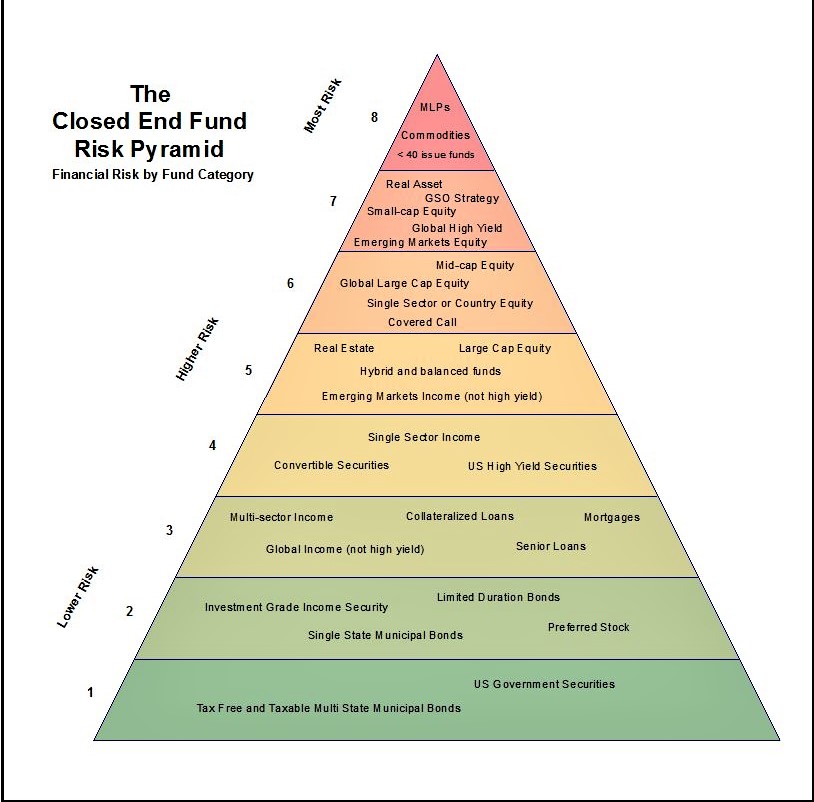Fifty-Six years ago, in Investments 101, "Pistol Pete" Williams jumped up on the chair next to his desk, pointed his fingers at his students and proclaimed: "if you don't take the time to thoroughly understand the Investment Risk Pyramid on page xx, the big guns on Wall Street will shoot your financial aspirations full of holes!"... or something to that effect.
The Risk Pyramid is basically an asset allocation tool for "financial" risk, as opposed to "market", "interest rate", "concentration", "sector", "region", "liquidity", "inflation" etc. If there is no risk (bank deposit, cash, money market), there is no investment, so most "classical" pyramids included these on the ground floor as a place, perhaps, where neophytes can just hang out until they learn a bit more about investing.
Most investing involves securities that represent debts owed to some entity by governments, corporations, or individuals and/or securities that represent ownership of corporations. Preferred stocks and other hybrid instruments exhibit both equity and debt qualities, but at least there is "something" that is actually owned.

More exotic types of products, those that literally place bets on the occurrence of future events or prices, either in securities or commodities, to me, are more speculations than they are investments. But there are forms of these, that are more secure than others, and that do have investment like features... especially their high income.
In portfolio management, there are three great "financial risk "minimizers" and one great "all other risk" minimizer... and they all apply to the securities inside the categories as well as to the "shells" that contain them. That's why professional management is always needed. The four:
• Selection Quality standards, strict Diversification rules, universal Income production, and disciplined/targeted Profit Taking
But let's not over complicate something that itself is complicated daily by too many factors and forces than need be mentioned here. Financial risk is simply the possibility of losing money because of a business or governmental failure that leads to bankruptcy, dissolution, or reorganization. Game over, pay the creditors, pay the salaries, get "outta" town (note that "pay the shareholders" just doesn't happen).
• So what type of security is most financially risky? Least? That's what the Risk Pyramid is all about. Probably over simplified, all "debt" instruments are less risky than all "equity" instruments, and all "equities" are less risky than all "futures" instruments.
But what about the packages of securities most of us are investing with these days? The ETFs, Mutual Funds, and Closed End Funds (CEFs)? It should be obvious to all of you that a diversified portfolio of securities, or of various types of securities, is less financially "risky" than any individual security, or security type, on its own.
Similarly, a professionally managed portfolio that is not forced to buy or sell shares based on public greed or panic is naturally safer than one ruled (and priced) by mob hysteria. Knowing all of this helps, because it allows us to classify, separate, and organize our financial products (the CEFs, ETFs, and MFs) into categories by the "paper" that's actually inside of them... and recognizing that only the CEFs are actually "managed".
That is what the members of the Closed End Funds for Retirement Income and Equity Trading Facebook Group have done. Their collaboration has come up with thirty categories of CEF (and it is likely that you could classify ETFs and Mutual Funds in the same manner) that have been organized into eight levels of overall financial risk.
Floors One through Four contain the least risky, "income" purpose securities, ranging from Municipal Bonds to Single Sector Income portfolios. Equities make their initial appearance on Floor Five along with Real Estate and Balanced Funds... men's formal wear and ladies handbags.
Floors Six and Seven contain Covered Call, Small Cap Equity, and Real Asset, while the Eighth Floor houses MLP Funds, Commodities and Overly Concentrated portfolios. Thirty categories may or may not be adequate, but following the parameters and descriptions above, any "missing" items should be easy to place appropriately.




